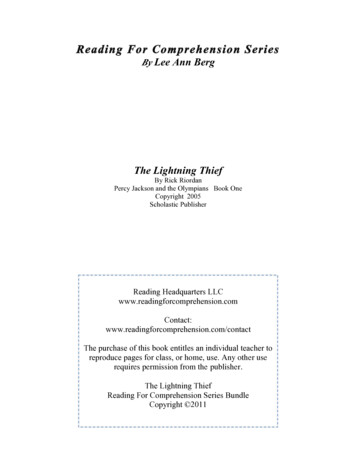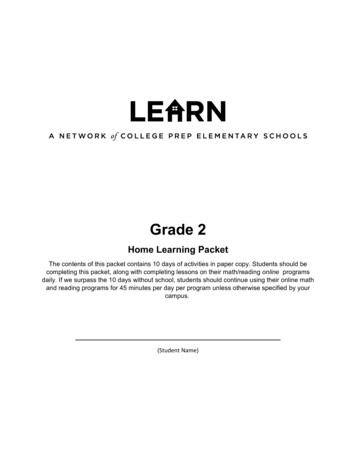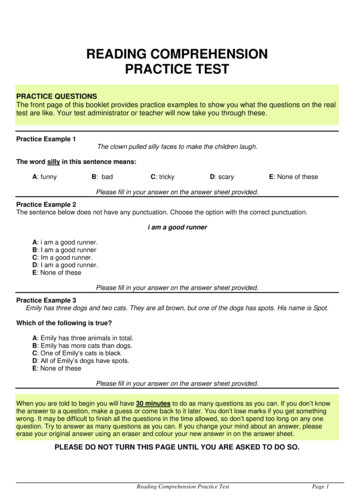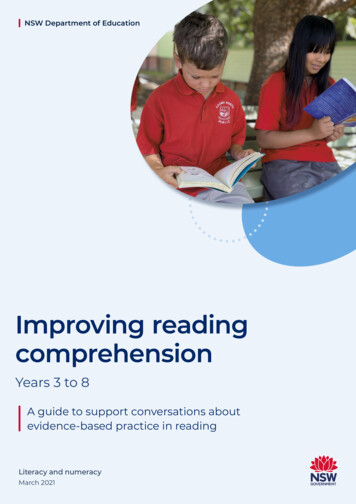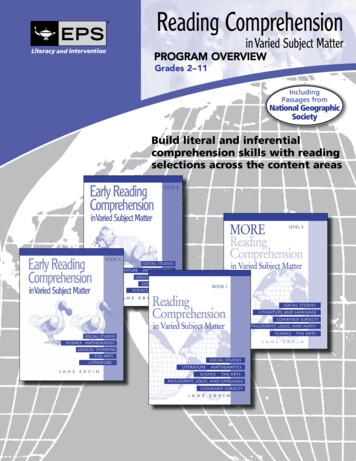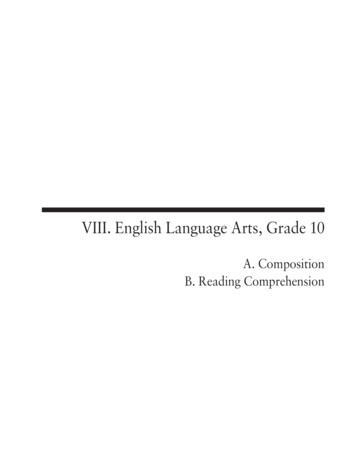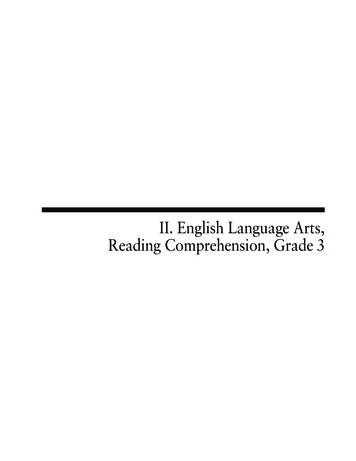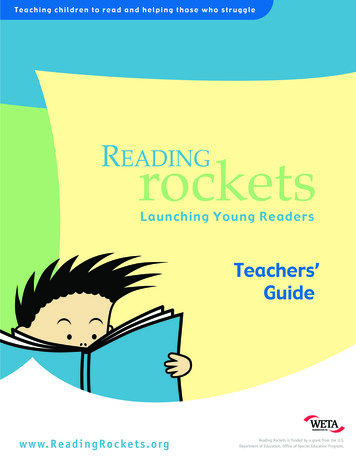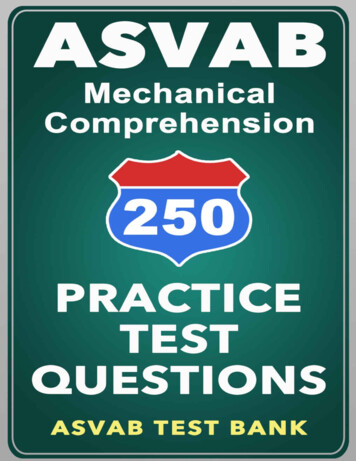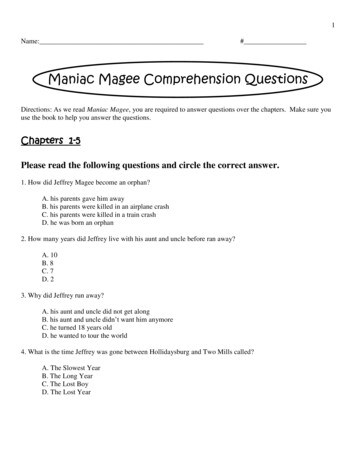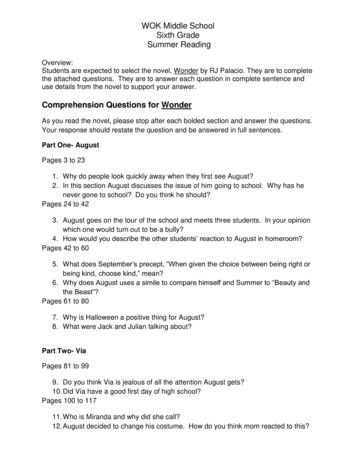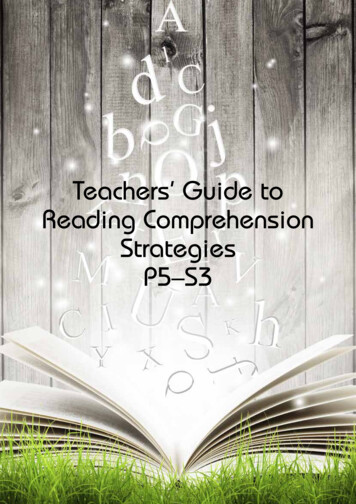
Transcription
Teaching Reading Comprehension P5–S3Teachers’ Guide toReading ComprehensionStrategiesP5–S31
Teaching Reading Comprehension P5–S32
Teaching Reading Comprehension P5–S3Teachers’ Guide toReading Comprehension StrategiesP5–S3Edinburgh Literacy HubThe City of Edinburgh CouncilEast Lothian CouncilWest Lothian CouncilMidlothian CouncilScottish Borders CouncilDumfries and Galloway Council3
Teaching Reading Comprehension P5–S3This teachers’ guide to teaching reading comprehension strategies is the result ofthe collaboration of:The City of Edinburgh CouncilEast Lothian CouncilWest Lothian CouncilMidlothian CouncilScottish Borders CouncilDumfries and Galloway Councilwith special thanks to:Karen Foster, Evelyn Love-Gajardo, Sharon Mitchell, Dr Marysia Nash, Gill Earl,Mary Murray, Emma Easton, Ashley Alphey, Alison Clark, Linda Sinclair, Rosie Daley,Jill Horsburgh, Kris Johnston and Kelton Green.4
Teaching Reading Comprehension P5–S3ContentsIntroduction7Reciprocal Reading roles 8Resources and lesson plans 11Developing Vocabulary for Reading Comprehension46Blooms and Higher Order Thinking Skills50AppendixReading Skills Leaflets: Reading Comprehension77Darts strategies 81Critical Literacy88Improving Reading through Drama 92Research106Reading Comprehension Resources1105
Teaching Reading Comprehension P5–S3IntroductionAs a result of Scottish Government funding, in 2013–2014 the Edinburgh literacy hubfocussed on two main priorities: reading comprehension P5–S3 and developing a readingculture. The hub partners agreed that ideally schools should promote both readingcomprehension skills and reading for enjoyment simultaneously to maximise the impacton learners’ skills and to nurture the love and enjoyment of reading.The reading comprehension operational group agreed to focus on improving the readingcomprehension skills of learners in P5–S3 and the decision to concentrate on reciprocalreading strategies was grounded in international research. * 1This guide leads practitioners through the teaching of the key reciprocal reading skillsin order to build confidence in the teaching of reading comprehension and providestemplates and models of how comprehension lessons can be structured. Due tocopyright restraints – it is difficult to provide numerous exemplar texts, but wherecopyright allows hyperlinks to on-line texts have been provided. Nevertheless, thegeneric strategies described can be applied to any text and, in a wider sense, to literacyacross learning.* 1 Appendix – A Summary of Research7
Teaching Reading Comprehension P5–S3Reciprocal ReadingThis model for teaching reading comprehension was developed in Australia, NewZealand and the US and is credited with raising attainment in reading. Its popularity hasgrown in the UK and it has come to be known by a variety of names: Reading Detectives,Reading Circles, Guided Reading, etc. All of these versions are based on the same simplemessages: It is reciprocal because you gradually give away more and more teacher control aspupils develop independence in groups, in pairs and the as individuals. The instructional concepts which underpin it include expert modelling, expertsupport as the child begins a task, children supporting each other and gradualreduction of support as pupils develop competence. Pupils are supported to develop reading strategies before, during and after reading. Pupils are encouraged to monitor their own reading abilities.Research shows that proficient and confident readers employ a number of strategies toachieve comprehension of text. Once decoding, fluency and automaticity (the ability todo things without occupying the mind, usually achieved through learning, repetition andpractise) have been addressed, young people need to be taught a range of strategies forcomprehension. Most versions select prediction, questioning, identifying (or clarifying)and summarising, though more recent studies have demonstrated and subsequentlypromote the importance of visualisation.Predicting Pupils preview the text to anticipate what may happen next. Pupils can useinformation from a text, accommodate it within their prior knowledge and use it tomake logical predictions before and during reading. Use of title, illustrations, sub-headings, maps, etc. Prediction is used to set a purpose for reading. It encourages pupils to interact withthe text and their prior learning; thus they are more likely to become interested inreading. A requirement of the new qualifications is that learners can identify thepurpose of what they read and supply evidence to show how they know that isthe purpose. Similarly, they must identify the target audience and give evidence toshow how they know who the audience is. These reading skills can be developed atprimary through prediction exercises.Questioning Formulating questions can be a difficult and complex task. However, when pupilsare told, prior to reading, that they need to think of a question, they read with moreawareness and purpose. During reciprocal reading, pupils are asked to generate questions which areanswered in the text. The questioning can focus on “Who, What, Where, When,Why and How” enquiries.8
Teaching Reading Comprehension P5–S3Identifying (Clarifying) Identifying encourages pupils to monitor their own comprehension as theyencounter barriers to comprehension (especially with vocabulary). Teachers model with pupils how to figure out a difficult word (re-read, look for partsof the word they know, read on and look for context clues, read the whole sentence,etc) and call on peers to share their own ideas. *2 Teachers and peers can also model dictionary, map-reading, encyclopedia and ITskills.Summarising Research has demonstrated that practise in summarising is extremely important indeveloping comprehension skills as it helps pupils construct a concise understandingof text. Teacher modelling is vital here, as summarising can be a complex task. Summarywheels are a useful resource as they focus on the following questions: ‘Who, What,Where, When, Why, How and So What?’ nisers-w.html Pupils are supported to construct summary statements based on their reading. See DARTS leaflets called ‘DARTS’ and ‘Interacting with texts darts’ on page ?Visualisation Pupils are encouraged to translate their literal understanding of text into pictorialform through the creation of a mental image. Visualisation can be achieved in a variety of ways, including the creation of characterstudies, charts, timelines, graphs or illustrations, etc (often called visual or graphicorganisers). *3 In order to achieve success, pupils must engage fully with the text, glean importantinformation and convert this knowledge into another form.PROMPT CARDS FOR EACH ROLE ON PAGES 12–15.* 2 Vocabulary info for teachers (Page 47-50)* 3 Appendix – Resources (Page 110)9
Teaching Reading Comprehension P5–S3ReferencesPalinscar, Anne-marie Sullivan and Brown, Ann L (1984) ‘Reciprocal Teaching ofComprehension-Fostering and Comprehension-Monitoring Activities’, Cognition andInstruction, 1: 2, 117–17510
Teaching Reading Comprehension P5–S3Resources andLesson Plans11
Teaching Reading Comprehension P5–S3Predicting Use the story clues and illustrations to predictwhat is going to happen next in the story or text. Use bullet points and the following prompts tohelp you:I think.I bet.I imagine.I predict. What is the purpose of this text?:to entertain?to inform?and how do you know?I wonder if.to persuade? Who are the target audience of this text and howdo you know?12
Teaching Reading Comprehension P5–S3Questioning Ask questions to help your group understand anddiscuss what has been read next time you cometogether. You should think of at least 8 questions as youread the book or text. Use the following questions, words and phrases tohelp:Where?ohW?tHow?ahW?Why?neWh13
Teaching Reading Comprehension P5–S3Clarifying Clear up any parts of the story you foundconfusing. Find examples of good vocabulary and explaintheir meaning. Find examples of unfamiliar words andpunctuation and explain their use or meaning.14
Teaching Reading Comprehension P5–S3Summarising Summarise the main things that happened in yourreading/story. Use bullet points and as few words as possible to do this. Use the following to create short summary sentences:The main events were:The problem/resolution was.The character(s) involved was/were.The story was set.The most important part of the story was.15
Teaching Reading Comprehension P5–S3The Behaviours of a Good ReaderDo you agree or disagree with the following statements? Why?1Reading aloud is about being able to say words without making mistakes.2I always read from the start of the book to the end.3I can hear different voices when characters are talking.4I usually read in my head.5I can create pictures in my head of the characters, the setting and the action.6If I don’t understand a word I try to guess what it might mean.7When I read, it sometimes makes me change my mind about something.8Sometimes I just flick through a book if I am looking for something special.9When I read, I ask myself questions about the text.10 If I don’t understand something I just keep on reading.11 I often wonder what might happen next.12 Sometimes I start reading from the back of the book.A Reader will: choose to read when given a choice of activities listen to stories with focus use different strategies to understand text avoid distractions exchange ideas and interpretations with other readers reflect upon their own reading habits find it difficult to analyse the strategies they use because the strategies used tocomprehend meaning have been practised regularly and rigorously until they areautomatic If they don’t understand: re-read; identify the problem; find out.16
Teaching Reading Comprehension P5–S3Text – breaking down the wall and how to use a wide range oftexts/media1picture23 holiday booking2lyrics24 weather broadcast3recipe25 horoscope4diagram26 concert tickets5road sign27 Ebay6map28 menu in school canteen7notice29 cartoon8match fixtures30 maths problem9text messages31 letter10 prescription32 prayer11 advert33 blog12 Facebook wall post34 instructions13 sign35 jokes14 label36 novel/short story15 address37 biography/autobiography16 diary38 picture17 TV listings39 radio article18 speech40 tv programme19 CD cover41 film trailer20 book cover42 film21 news headlines43 you tube clip22 Film posters17
Teaching Reading Comprehension P5–S3Pupil QuestionnaireThe Behaviours of a Good Reader?Do you agree or disagree with the following statements? Why?1Reading aloud is about being able to say words without making mistakes.2I always read from the start of the book to the end.3I can hear different voices when characters are talking.4I usually read in my head.5I can create pictures in my head of the characters, the setting, the action.6If I don’t understand a word I try to guess what it might mean.7When I read, it sometimes makes me change my mind about something.8Sometimes I just flick through a book if I am looking for something special.9When I read, I ask myself questions about the text.10 If I don’t understand something I just keep on reading.11 I often wonder what might happen next.12 Sometimes I start reading from the back of the book.18
Teaching Reading Comprehension P5–S3Using Context Clues in Reading(Below are suggestions of strategies pupils may use to access text and gain more of anunderstanding of what they read)a)Read the word againb) Look at the start sound/letterc)Look at the shape of the wordd) Read the illustrations around the texte)Read to the end of the sentencef)Read to the end of the paragraphg)Break up the wordh) Sound it outi)Chop into syllablesj)Look at the end of the wordk)Say out loud what you think it isl)Think of a word familym) Look for smaller words inside the wordn) Look at the length of the wordo) Look at the title of the textp) Look at the headings in the textq) Look at how the text is set outr)Look at the features of the texts)Cover parts of the wordt)Does it remind you of another word/text/etc?u) Does it have many long descriptive sentences or short, focussed sentences?v)Chunk text to break up the reading or to re read to ensure greater understandingw) Makes notes as you go (could be something you think is important/difficultvocabulary)19
Teaching Reading Comprehension P5–S3Identifying purpose and audience in texts you readGood readers can explain the purpose and target audience of the texts they read andprovide evidence to back up their answer.Look at these texts below and for each one complete a grid like this. There is a blank gridover the page.The purpose could be:For the audience – think about:to inform - ageto persuade - nationalityto entertain - gender- interestsTextnumberPurpose of thetextEvidenceHow do youknow?Target audience Evidenceof the textHow do youknow?1Scientists identify biological cause of ME2The Wizard of Oz 2.30pm Channel 4 – Dorothy Gale ( Judy Garland) follows theyellow brick road of self-discovery in this much-cherished film. It is MGM’s mostmagical musical3Simply Lake Garda – 10 days from 1,225 – Picturesque, peaceful and perfectlyplaced for visits to Verona and Venice, Lake Garda is a wonderful choice for arelaxing holiday.4Sticky Chicken Drumsticks – 1. To make the marinade, pour the honey into a smallstainless steel saucepan and warm on a medium-high heat. Cook the honey until itstarts to turn a deep rich shade of amber, then pour in the soy sauce and chickenstock.20
Teaching Reading Comprehension P5–S35Boots Hearing Care – Have you seen our invisible hearing aid yet? No? Not at all?Exactly.Our fantastic invisible hearing aid is small. Really small. And because it fits slightlydeeper in the ear canal than your average hearing aid, it’s virtually invisible whenworn.6The group of girls leaped off the bus, school bags flying behind them and thencharged down the alleyway. I watched from a safe distance as the girls caught upwith their prey and cornered him. ‘You’re dead,’ the tallest girl squared up to Ryan,‘think it’s cool to pick on little kids, do you?’7Royal Mail to increase the price of stamps by 1pNow your turn – write your own short paragraph for some of the following purposesand audiences:1To inform younger children about what to expect on their first school trip to themuseum or local historical site.2To persuade local parents to send their children to your school.3To entertain your class – write a joke or funny story that would be suitable to readaloud to your class.4To persuade your parents to buy you the birthday present of your dreams.5To inform younger children of the rules of your favourite game or sport.Think about how your word choice, type of sentences and style will help to create theright tone.21
TextnumberPurpose of the textEvidenceHow do you know?Target audience of the textEvidenceHow do you know?Teaching Reading Comprehension P5–S322
TextnumberPurpose of the textEvidenceHow do you know?Target audience of the textEvidenceHow do you know?Teaching Reading Comprehension P5–S323
Teaching Reading Comprehension P5–S3Directed activities related to texts (DARTs)Good readers use what they know about language and the world to interact withwhat they are reading. This helps them create meaning from the words on the page.Classroom activities that encourage interaction with texts, like directed activities relatedto texts (DARTs), improve reading comprehension.Directed activities related to texts (DARTs) Types of activities used in DARTs Type of texts used in DARTs Advantages of using DARTs Developing DARTs1DARTs activities help interaction with texts. The aim is to improve readingcomprehension and create critical readers. They can be done by individual pupils orgroups.2Activities used in DARTs-DARTs can be divided into: reconstruction and analysisactivities.Reconstruction activities require pupils to reconstruct a text or diagram by filling inmissing words, phrases or sentences, or by sequencing jumbled text.Texts used: modified texts – the teacher modifies the original text, taking out words,phrases or sentences, or cutting the text into segments.Types of activities: Text completion (Fill in missing words, phrases or sentences) Sequencing (Arrange jumbled segments of text in a logical or time sequence) Grouping (Group segments of text according to categories) Table completion (Fill in the cells of a table that has row and column headings, orprovide row and column headings where cells have already been filled in) Diagram completion (Complete an unfinisheddiagram or label a diagram) Prediction activities (Write the next step orstage of a text, or end the text)24
Teaching Reading Comprehension P5–S3Analysis activitiesDefinition: activities that require pupils to find and categorize information by marking orlabelling a text or diagram.Texts used: unmodified textsTypes of activities: Text marking (Find and underline parts of the text with particular meaning orinformation) Text segmenting and labelling (Break the text into meaningful chunks and label) Table construction (Draw a table using information to decide on headings and to fillcells) Diagram construction (Construct a diagram that explains the meaning of the text,eg draw a flow chart to explain a process or a branch diagram to describe howsomething is classified) Questioning (Answer the teacher’s questions or develop questions about the text) SummarisingType of texts used in DARTsDARTs can be used with traditional language texts like poems and extracts fromshort stories, novels and plays. You can also base them on extracts from magazines,newspapers, pamphlets, etc and passages from history, geography, science etctextbooks.Advantages of using DARTs: Interaction with texts improves reading comprehension. Awareness of how texts are constructed. Makes readers think more critically by asking questions about what has beenincluded and excluded from the text and about words and sentence constructionsthat the writer chose. Understanding of how text is constructed improves, which, in turn, improveswriting. Interacting with texts also improves cognitive development. DARTs aid learning of how to produce graphic charts.25
Teaching Reading Comprehension P5–S3How to develop your own DART:As an adult reader, read a text carefully. As you read, interact with the text (eg underlineor circle important information, write questions, list main ideas and the supportingdetail, draw a table or a diagram, etc.)Note your own interaction with the text.If the text you may have developed compared and contrasted two or more things described a process described a fictional or non-fictional sequence ofevents described how something can be classified described an object presented an argumenta table or Venn diagrama flow charta flow charta branch diagrama labelled diagrama spider diagram or mind mapUse your notes as a basis for creating your own DART: If you developed a flow chart while reading the text and you want your pupils to doa reconstruction activity, develop a relevant flow chart and then delete some of theinformation from the chart. If you developed a flow chart while reading the text and you want your pupils to doan analysis activity, write the instructions that will help them construct their ownflow chart. Firstly, you might ask your pupils to underline the steps in the processthat is being described. Then you might ask them to draw a flow chart and fill ininformation.MORE DARTS INFORMATION (Page 81)26
Teaching Reading Comprehension P5–S3Lesson:Focus: Note-makingExperiences and Outcomes:I can make notes, organisethem under suitableheadings and use them tounderstand information,develop my thinking,explore problems and createnew texts, using my ownwords as appropriate.LIT 2–15aLearning Intentions:To make notes from various non-fiction texts.Link to prior learning:Refer to previous note-making activities and methods of note-making. Ask talk partnersto discuss the methods they have used and for what purpose.Take feedback. Prompt pupils to think of reasons for making notes: to summarise the main points of a text;to note particular aspects of the text;to make a record;as a revision tool – very important for assessments.Tell pupils that different methods suit different purposes.Explain to pupils that they are going to practise their note-making skills in this lesson. Saythat note-making is a complex skill: it involves lots of other skills. You will be taking themthrough it step by step.Model (Teacher-led explanation and demonstration):Ask pupils what they know about the Winter Olympic Games 2014.Ask pupils to skim read ‘The Modern Olympic e/modern-olympic-gamesNow tell them that you are going to scan the text with them as they read and listen. Thepurpose of their listening and, later, their note-making will be to answer the question:Why did the modern Olympic Games begin?Ask pupils to follow along as you scan and to think about the main points to do with theorigins of the modern Olympic Games.27
Teaching Reading Comprehension P5–S3Cover the text and ask talk partners to write on their whiteboards five or six key wordsthat sum up the key ideas on the origins of the modern Olympic Games.Take feedback and select five words to write on five blank cards, (eg education,excellence, fair-play, inclusive, evolving). Display the cards on the board or a flipchart.Model selecting the important information from the text and turning it into two or threebullet points which expand on one of the selected words (eg inclusive). Copy the bulletpoints onto the card. Return the card to the board with the others.inclusion encourage all nations need NOC events for womenTry (Collaboratively with the support of peers):Ask talk partners to make cards for their own key words, adding supporting bullet pointsdrawn from the text.Provide an overview of different kinds of note-making arrangements, eg linear, explosionchart, retrieval chart (or grid), tree diagram, Tell pairs to decide how they will organisetheir cards - as an explosion chart, tree diagram, in a line, etc.Select pairs to share examples of their bullet points.Select other pairs to tell how they organised their notes and why they chose that format.Apply (Independent working):Direct pupils to ‘The History of the Commonwealth wealth-games/history.htmExplain that, working on their own, they are going to make notes to answer the question:Why did the Commonwealth Games begin?Secure (Plenary session – teacher checks learning of whole class):With the whole class recap how pupils have learned how to make notes:1First skim to gain a quick impression of the information.2Scan to find the relevant information.3Close read to understand.4Reread and change into short form.5Repeat notes in your head to clarify what you are saying then write them down.28
Teaching Reading Comprehension P5–S3Next steps/consolidation of learning:Pupils could be asked to research and make notes of the events that take place in theCommonwealth Games.Pupils could be asked to research and make notes about the people who take part in theCommonwealth Games.Pupils could be asked to research and make notes about another sporting event, egFormula 1, Rallying, Horse Racing, Vocabulary:bullet pointsexplosion chartflow diagramconcept map grid headingsirrelevantsubheadingstimelinetree diagramResources:mini whiteboardssmall blank cardsboard or flipcharttextsEvidence of pupil achievement:Pupils will be able to pick-out key points which are wholly relevant.29
Teaching Reading Comprehension P5–S3Lesson:World War IIFocus: Scanning for .uk/Catalogue ref: HS pdf/we-resistance.pdf (see pages 7 and 8 – extracts a, b and c)Experience & Outcome:Using what I know about the features of different types of texts, I can find, select andsort information from a variety of sources and use this for different purposes. LIT 2–14aLearning Intentions:To know how to extract specific information.To review their own reading strategies.Links to prior learning:To have some knowledge about the German invasion of Poland during World War II.To have some understanding about the role of spying during the war.To understand why the British would recruit the services of a foreign national.Model (Teacher-led explanation and demonstration):Explain that to find particular information in a text readers need to scan. This means notreading every word closely but searching for key words and numbers quickly. Tell pupilsthat they are going to be noticing what their eyes do when they scan for information.Tell pupils that a good way to get an overview of a non-fiction text is to do a quick TAPSanalysis. Ask them to identify the: Text typeAudiencePurposeSourceAsk pupils in pairs to make up4 simple questions about thetext using the question –Starters: who? what? where?when? how? how many?why?Now model scanning tofind the answers to thepupils’ questions, using your finger or a pen to track eye movement. You could continuemodeling locating the information, formulating the answer and demonstrating thewritten response for the next two questions, if you think the pupils need more guidancebefore working on their own.30
Teaching Reading Comprehension P5–S3Try (Collaboratively and with the support of peers):After scanning the text pupils will work collaboratively to answer their remainingquestions and to then sum up the main points from the extract they have read. They cancompare their findings with another group.Apply (Independent working):They will develop a profile of the main protagonist and make a list of the skills thatwould have made him/her attractive to the British Secret Service.Secure (Plenary session – teacher checks learning of whole class):Ask pupils to work with their talk partners. One should explain to the other: what scanning is;how question words and key words can help a reader locate information.Next steps/consolidation of learning:More opportunities to be provided to allow pupils to scan text to find specificinformation using non-fiction texts. ‘Where’s Wally?’ books can also provide a fun way topractise scanning.Vocabulary: audience, close reading, continuous reading, purpose, scan, skim, source,text type.Resources:National Archives extract ‘What was the role of special operations executive and whatkind of people worked for it?‘Catalogue ref: HS 9/612Evidence of pupil achievement:Are the pupils able to extract specific information?Are they able to review their own reading strategies?31
Teaching Reading Comprehension P5–S3Lesson:Focus: Using different strategies to access textExperiences and Outcomes:I can select and use a range of strategies and resources before I read and as I read, tomake meaning clear and give reasons for my selection. LIT 2–13aLearning Intentions:To be able to use a range of strategies to make sense of different texts.Link to prior learning:What makes a text difficult to read? What do pupils do already to help access text orwhen they do not understand a text?1 Model (Teacher-led explanation and demonstration):Before Reading – What kind of text is this? How do you know? What do you think thistext will tell us about? Teacher takes note of ‘before reading’ responses. Teacher readsthe text with the pupils. (Text 1 Mercury)During Reading – Create questions as the text is read.After Reading – Show prepared ‘ideas’/concept map (Text 2) and draw connecting lineswith explanatory notes along the lines. Explain that one word or phrase may connect tomore than one other ‘idea’.2 Try (Collaboratively with the support of peers):Continue to mark, annotate and link the given ideas map.Ask partners/cooperative learning groups to share ideas. Add contributions. Invitedifferent responses, eg Does anyone have anything different?Ask pupils to take a different coloured pen, to read the text again and tick all the ideasnoted.Underline evidence to show ideas are correct. Ask pupils what makes the task easier, egthinking about what you already know, making predictions, becoming familiar with somespecialist vocabulary, knowing the purpose of the task, discussing ideas with a partner orin a small group.3 Apply(Paired task):Pupils work in pairs to activate prior learning/discuss quickly what they already knowabout, eg volcanoes.Pupils should read the Text 3 – Volcanic Eruption text and highlight specialist nouns inone colour and action verbs in another colour. They should use the subheadings in thetext to help them label the diagram on the activity sheet.32
Teaching Reading Comprehension P5–S3Pupils are able to present their learning of a volcanic eruption using an ideas map/diagram. Pupils should then share how they worked through the task and importantly,what they did when they found the text difficult to understand.4 Secure (Independent working):Pupils work independently to read Text 4 (Jade Burial ements/bk497-text-jade-burial-suits.pdfThey should present their learning in a format of their choosing and share the threemain strategies they used to help them understand the text.Plenary – teacher checks learning class by recapping how pupils have learned how to usedifferent strategies to help them understand what they read.Next steps/Consolidation of learning – teaching of how different kinds of texts requiredifferent strategiesKey vocabulary:ideas mapconcept tnotesResources:mini whiteboardssmall blank cardsboard or flipcharttextsEvidence of pupil achievement:Pupils will be able to us
Teaching Reading Comprehension 5S3 Reciprocal Reading This model for teaching reading comprehension was developed in Australia, New Zealand and the US and is credited with raising attainment in reading. Its popularity has grown in the UK and it has come to be known by a variety of names:
